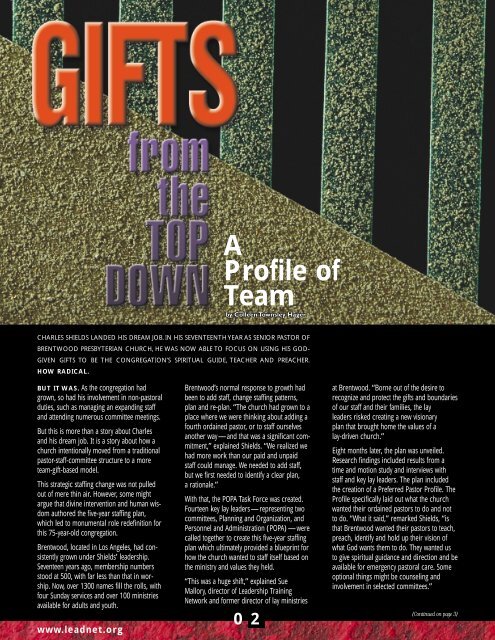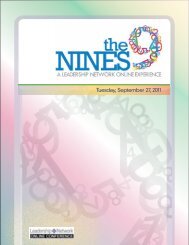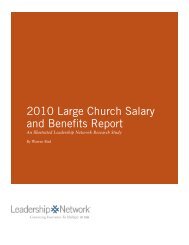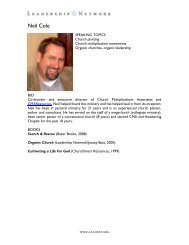ARE WE A PEOPLE AT HALF TIME? - Leadership Network
ARE WE A PEOPLE AT HALF TIME? - Leadership Network
ARE WE A PEOPLE AT HALF TIME? - Leadership Network
You also want an ePaper? Increase the reach of your titles
YUMPU automatically turns print PDFs into web optimized ePapers that Google loves.
A<br />
Profile of<br />
Team<br />
CHARLES SHIELDS LANDED HIS DREAM JOB. IN HIS SEVENTEENTH YEAR AS SENIOR PASTOR OF<br />
BRENTWOOD PRESBYTERIAN CHURCH, HE WAS NOW ABLE TO FOCUS ON USING HIS GOD-<br />
GIVEN GIFTS TO BE THE CONGREG<strong>AT</strong>ION’S SPIRITUAL GUIDE, TEACHER AND PREACHER.<br />
HOW RADICAL.<br />
BUT IT WAS. As the congregation had<br />
grown, so had his involvement in non-pastoral<br />
duties, such as managing an expanding staff<br />
and attending numerous committee meetings.<br />
But this is more than a story about Charles<br />
and his dream job. It is a story about how a<br />
church intentionally moved from a traditional<br />
pastor-staff-committee structure to a more<br />
team-gift-based model.<br />
This strategic staffing change was not pulled<br />
out of mere thin air. However, some might<br />
argue that divine intervention and human wisdom<br />
authored the five-year staffing plan,<br />
which led to monumental role redefinition for<br />
this 75-year-old congregation.<br />
Brentwood, located in Los Angeles, had consistently<br />
grown under Shields’ leadership.<br />
Seventeen years ago, membership numbers<br />
stood at 500, with far less than that in worship.<br />
Now, over 1300 names fill the rolls, with<br />
four Sunday services and over 100 ministries<br />
available for adults and youth.<br />
www.leadnet.org<br />
Brentwood’s normal response to growth had<br />
been to add staff, change staffing patterns,<br />
plan and re-plan. “The church had grown to a<br />
place where we were thinking about adding a<br />
fourth ordained pastor, or to staff ourselves<br />
another way—and that was a significant commitment,”<br />
explained Shields. “We realized we<br />
had more work than our paid and unpaid<br />
staff could manage. We needed to add staff,<br />
but we first needed to identify a clear plan,<br />
a rationale.”<br />
With that, the POPA Task Force was created.<br />
Fourteen key lay leaders—representing two<br />
committees, Planning and Organization, and<br />
Personnel and Administration (POPA)—were<br />
called together to create this five-year staffing<br />
plan which ultimately provided a blueprint for<br />
how the church wanted to staff itself based on<br />
the ministry and values they held.<br />
“This was a huge shift,” explained Sue<br />
Mallory, director of <strong>Leadership</strong> Training<br />
<strong>Network</strong> and former director of lay ministries<br />
0<br />
2<br />
at Brentwood. “Borne out of the desire to<br />
recognize and protect the gifts and boundaries<br />
of our staff and their families, the lay<br />
leaders risked creating a new visionary<br />
plan that brought home the values of a<br />
lay-driven church.”<br />
Eight months later, the plan was unveiled.<br />
Research findings included results from a<br />
time and motion study and interviews with<br />
staff and key lay leaders. The plan included<br />
the creation of a Preferred Pastor Profile. The<br />
Profile specifically laid out what the church<br />
wanted their ordained pastors to do and not<br />
to do. “What it said,” remarked Shields, “is<br />
that Brentwood wanted their pastors to teach,<br />
preach, identify and hold up their vision of<br />
what God wants them to do. They wanted us<br />
to give spiritual guidance and direction and be<br />
available for emergency pastoral care. Some<br />
optional things might be counseling and<br />
involvement in selected committees.”<br />
(Continued on page 3)







